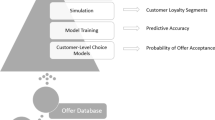Abstract
We propose a systematic procedure for assessing the end price of an item in a C-to-C auction site. These sites deal with used product and the product features vary substantially even within a single product category that makes price assessment difficult. Besides, the true market demand at a particular time, the effect of spurious bidding activities also contributes to price variation. We suggest removing outliers, selecting the right features and clustering the product data can increase the prediction accuracy. Using a multivariate dataset from eBay on Dell Laptops, we show, the prediction accuracy using back propagation neural network improves considerably when used in combination with the methods for (1) removing outliers using Support Vector Data Description, (2) selecting the right features using mutual information as a measure, and (3) clustering of the datasets.
Similar content being viewed by others
References
Bajari, P., & Hortacsu, A. (2003). The winner’s curse, reserve prices and endogenous entry: empirical insights from eBay auctions. The RAND Journal of Economics, 34(2), 329–355.
Battiti, R. (1994). Using mutual information for selecting features in supervised neural net learning. IEEE Transactions on Neural Networks, 5(4), 537–550.
Ben-Hur, A., Horn, D., Siegelmann, H. T., & Vapnik, V. (2001). Support vector clustering. Journal of Machine Learning Research, 2, 125–137.
Chan, H. C. (2008). Intelligent spider for information retrieval to support mining-based price prediction for online auctioning. Expert Systems with Applications, 34, 347–356.
Crisianini, N., & Taylor, J. S. (2000). An introduction to support vector machines and other kernel-based learning methods (1st ed.). Cambridge: Cambridge University Press.
Ghani, R. (2005). Price prediction and insurance for online auctions. In Proceedings of the eleventh ACM SIGKDD international conference on Knowledge discovery in data mining, Chicago, Illinois, USA, August 21–24 (pp. 411–418).
Ghani, R., & Simmons, H. (2004). Predicting the end-price of online auctions. In Proceedings of international workshop on data mining and adaptive modelling methods for economics and management held in conjunction with the 15th European conference on machine learning (ECML/PKDDD 2004).
Haykin, S. (2004). Neural networks, a comprehensive foundation. Canada: Prentice Hall International.
Kauffman, R. J., & Wood, C. A. (2005). The effects of shilling on final bid prices in online auctions. Electronic Commerce Research and Applications, 4, 21–34.
Krishna, V. (2002). Auction theory (1st ed., pp. 14–31). San Diego: Academic Press.
Kwak, N., & Choi, C.-H. (2002). Input feature selection by mutual information based on Parzen window. IEEE Transactions on Pattern Analysis and Machine Intelligence, 24(12), 1667–1671.
Lin, C., Chou, S., Chen, C., Ho, T., & Hsieh, Y. (2006). A final price prediction model for online English auctions—a neuro fuzzy approach. In Joint conference on information sciences.
Lucking-Reiley, D., Bryan, D., Prasad, N., & Reeves, D. (2007). Pennies from eBay: the determinants of price in online auctions. Journal of Industrial Economics, 55(2), 223–233.
Mehta, K., & Lee, B. (1999). An empirical evidence of winner’s curse in electronic auctions. In Association for information systems, Atlanta, GA, USA (pp. 465–471).
Peng, H., Long, F., & Ding, C. (2005). Feature selection based on mutual information criteria of max-dependency, max-relevance, and min-redundancy. IEEE Transactions on Pattern Analysis and Machine Intelligence, 27(8), 1226–1238.
Scholkopf, B., Mika, S., Burges, C. J. C., et al. (1999). Input space versus feature space in kernel-based methods. IEE Transactions on Neutral Networks, 10(5), 1000–1017.
Shah, H. S., Joshi, N. R., Sureka, A., & Wurman, P. R. (2003). Lecture notes on artificial intelligence. Mining for bidding strategies on eBay. Berlin: Springer.
Tabarzad, M. A., Lucas, C., & Haghjoo, P. (2006). A heuristic price prediction and bidding strategy for Internet auctions. International Journal of Computer Science and Network Security, 6(9), 161–166.
Tax, D. (2001). One-class classification. Ph.D. thesis Delft University of Technology.
Tax, D. M. J., & Duin, R. P. W. (1999). Support vector domain description. Pattern Recognition Letters, 20, 1191–1199.
Tax, D. M. J., & Duin, R. P. W. (2004). Support vector data description. Machine Learning, 54, 45–66.
van Heijst, D., Potharst, R., & van Wezel, M. (2008). A support system for predicting eBay end prices. Decision Support Systems, 44, 970–982.
Vapnik, V. N. (1995). The nature of statistical learning theory. New York: Springer.
Wang, S., Jank, W., & Shmueli, G. (2006). Forecasting eBay’s online auction prices using dynamic model, TDM’06, Philadelphia, Pennsylvania, USA.
Wang, S., Jank, W., & Shmueli, G. (2008). Explaining and forecasting online auction prices and their dynamics using functional data analysis. Journal of Business and Economic Statistics, 26(2), 144–160.
Wasserman, P. D. (1993). Advanced methods in neural computing. New York: Van Nostrand/Reinhold.
Wellman, M. P., Reeves, D. M., Lochner, K. M., & Vorobeychik, Y. (2004). Price prediction in a trading agent competition. Journal of Artificial Intelligence Research, 21, 19–36.
Xuefeng, L., Lu, L., Lihua, W., & Zhao, Z. (2006). Predicting the final prices of online auction items. Expert Systems with Applications, 31, 542–550.
Author information
Authors and Affiliations
Corresponding author
Rights and permissions
About this article
Cite this article
Jenamani, M., Routray, A. & Singh, V. A procedure using support vector data description and mutual information for end price assessment in online C2C auction. Electron Commer Res 11, 321–340 (2011). https://doi.org/10.1007/s10660-011-9079-z
Published:
Issue Date:
DOI: https://doi.org/10.1007/s10660-011-9079-z




